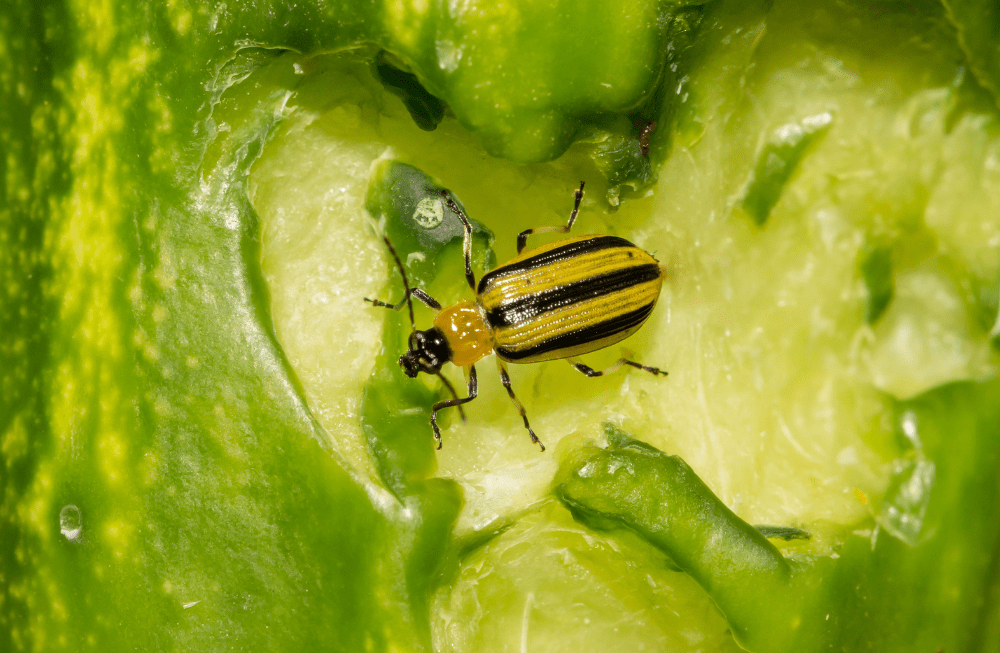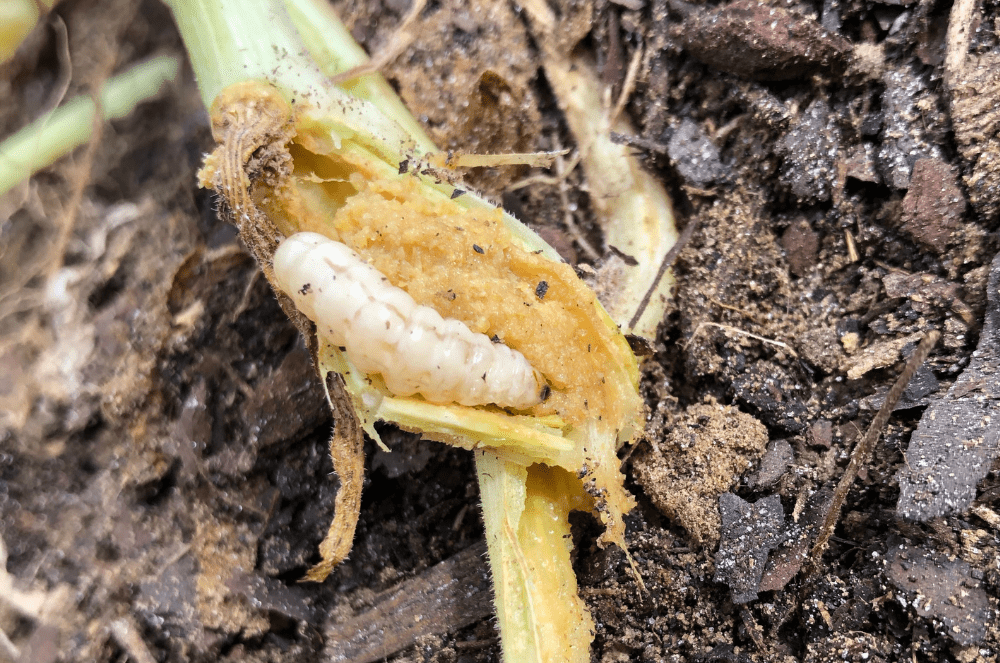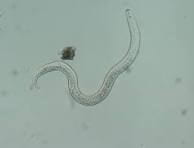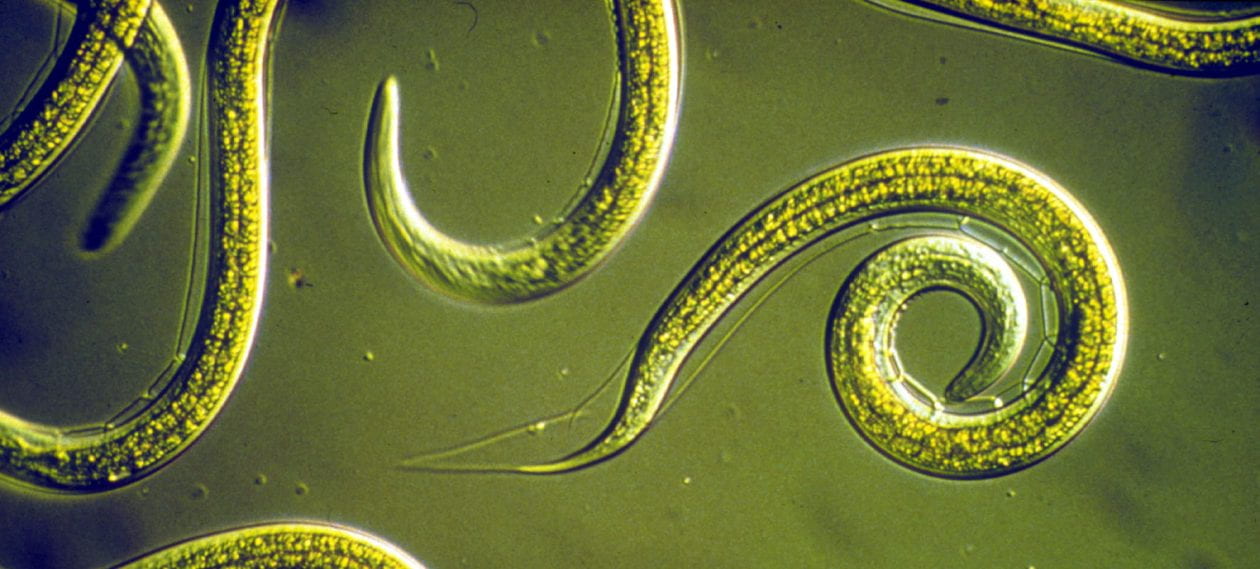One of the most difficult things for me to deal with as an organic gardener is how to control insect pests in my garden and small orchard. There are times that none of the organic controls that I implement do a very good job in controlling insect damage. The two insect culprits I find the most difficult to control are striped cucumber beetles and squash vine borers, both of which feed on plants in the curcurbit family which includes squash, melons, pumpkins, and zucchini. I’d like to share a bit more about these insects and then about how I’m using beneficial nematodes to control their population in my garden.
Cucumber beetles have evolved to perfectly time their emergence from the soil to coincide with the time cucumber seeds germinate and pop out of the ground. The first generation of beetles overwinter in the soil, undergo pupation, and then emerge as adults. Their first order of business is to attack the new cucumber plant’s first two leaves (called cotyledons) and then any new leaves and stems that have grown. Adult feeding can set back plant growth and may at times even kill the plant altogether. Adult beetles will then breed and females lay their eggs on the soil at the base of the plant. Eggs hatch in a few weeks and larvae burrow into the soil to begin feeding on roots and parts of the plant stem underground.

And that’s just the first generation of beetles! If you’re lucky enough that your plants survive the initial round of attack and are thriving under the June sun, a second generation of beetle larvae are busily consuming roots and maturing in the soil. About 40 days after hatching, the new brood of adult beetles will emerge to feed heavily on the flowers, leaves, and vines of your plants. This second generation of beetles will not only set back plant growth and fruiting, but may also introduce bacterial wilt into the plants. Bacterial wilt closes off the transport of water up the stems and to the developing fruit, causing the plant to wilt and die over just a few days. Eggs are again laid on the soil surface, they hatch, and larvae dig into the soil looking for roots to feed on. These larvae will overwinter in the soil to emerge the following spring as adults.
And then there’s the squash vine borer, which starts out as a beautiful moth that flies around the garden searching for a squash plant. Squash vine borers, unlike other moths, are active during the day and are readily visible as they fly about. Once the female borer locates a squash plant, she lays her eggs on the squash plant’s stem just above the soil line.

Within a few days these eggs hatch and the newborn larvae burrow into the center of the plant stem. As the larvae grow and develop, they hollow out the squash vine, cutting off the flow of water and nutrients to flowers and developing squash, eventually killing the vine. In St. Lawrence County, adult squash vine borer moths emerge from the soil the first few weeks of July (whenever 1,000 growing degree days are reached). Adult moths will be in the garden for around 30 days.

The larvae of both the cucumber beetle and squash vine borer will overwinter in our garden soil, ready to emerge when the time is right the following year. Crop rotation, moving the planting location of squash and cucumber plants, may help reduce damage from both insect pests.
It is my intention to use organic methods to control these and other garden pests. I start my cucumber and squash plants indoors to give them a head start on our short growing season. When I transplant seedlings to the garden or raised bed I protect them from insects using floating row covers. I leave them in place up until the plants begin to flower. Unfortunately beetles do emerge from the soil under the row covers and find a nice, safe, protected place with their favorite food source! Once the garden covers are removed the kitchen is then open for all cucumber beetles and squash vine borer moths emerging from soil across the entire garden.
In an attempt to control adults, eggs and larvae of these species I have used organic pesticides like neem oil and pyrethrum with limited success. The timing when applying a pesticide can be complicated. Usually these pesticides are applied when plants are flowering, just when pollinators are working in the garden. Unfortunately pesticides, even organic ones, do not discriminate between pest insects, pollinators, or other beneficial insects and will kill all equally. Pesticide applications must be applied either early in the morning or just before dark to avoid killing pollinators and other beneficial insects.
A few years ago, St. Lawrence County Master Gardener Volunteer Carolyn Filippi gave a presentation to our Master Gardener group on the use of beneficial nematodes to assist in controlling garden pests.

University
What is a nematode? Beneficial nematodes are tiny, usually microscopic roundworms that are applied to soil to help control pests in the garden, lawn, orchard, or home. They are safe for people and pets. Our soils naturally contain these nematodes, usually in low densities. By greatly increasing beneficial nematode populations it is hoped that targeted insect pests will have their populations reduced by up to 80 percent.
I wondered if this was a method to help me get on top of this frustrating beetle/borer problem. So last fall I decided it was time for a new approach to control cucumber beetles and squash vine borers. I decided to give beneficial nematodes a try. I took the initiative and ordered 10 million(!) nematodes of two different species (Heterorhabditis bacteriophora (Hb) and Steinernema feltiae (Sf)). Hb and Sf nematodes were identified as being particularly suited to control cucumber beetles and squash vine borers.
Beneficial nematodes can be easily ordered from a number of on-line organic suppliers. All the supplier websites provide information about the biology of nematodes and a “Pest Guide” which explains which nematode species to order for your particular pest problem. The supplier I ordered through, “NaturesGoodGuys,” lists 96 different pests that can be controlled, from ants and armyworms to wood borers and wooly aphids. The number of nematodes to order is based on the square footage of the area you want to treat.
In mid-September, my order of 10 million nematodes arrived in a tiny ziplock bag. The nematode cyst encased eggs looked like tiny white grains of sand. Application was a simple process: mix the nematodes with water and apply to the soil with a sprayer or watering can.
Application should be done late in the day to avoid the hot sun and soils should be kept wet for two weeks. The newly hatched nematodes will burrow into the soil seeking out larvae, pupae, and in some cases the adults of their intended prey. Interestingly, nematodes may not kill their host prey directly. When feeding on the host they will release from their gut a bacteria which will kill the infected prey in 7 to 10 days. The nematode will leave the dying grub and seek out new hosts.
I’m excited to see how this all works out. This May I will release another 15 million nematodes including a third species of nematode (Steinernema carpocapsae (Sc)) to help control codling moths in my orchard.
Wish me and my garden plants luck! I’ll give an update late in the summer to let you know if this is a viable way to control insect pests. As always, contact Master Gardener Volunteers with your garden questions: SLCgrowline@gmail.com.
Ken Kogut has been a Master Gardener Volunteer since 2014. A retired NY DEC Natural Resource Supervisor and Wildlife Biologist, Ken now spends his time maintaining his garden, berry patches, and small orchard with a goal of living sustainably off his property. He particularly enjoys helping county residents solve their gardening issues, writing short articles for gardeners, and teaching new gardeners in Seed to Supper classes.
